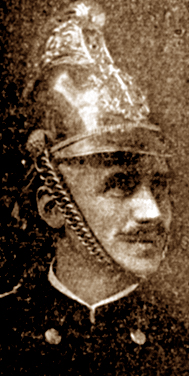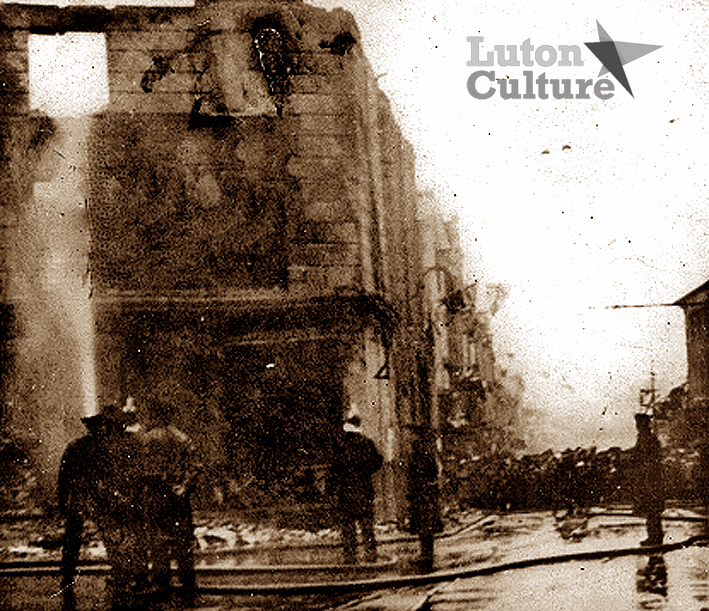
[Beds & Herts Saturday Telegraph: August 2nd, 1919]
The Borough Justices continued on Thursday morning [July 31st, 1919] their heavy task in dealing with the long list of prisoners who appeared before them on charges arising from the Peace riots in Luton. Another long day's sitting resulted in a considerable addition to those who will be called upon to take their trial before Judge and jury at the next Beds Assizes in October.
 General evidence was given by Chief Officer Alexander Andrew, (pictured right) of the Luton Fire Brigade. He said he received the call to the fire at the Town Hall at 10.30pm. At that time only five other men were at the station.
General evidence was given by Chief Officer Alexander Andrew, (pictured right) of the Luton Fire Brigade. He said he received the call to the fire at the Town Hall at 10.30pm. At that time only five other men were at the station.
The Brigade had been out twice previously that night to fires in Bailey Street and Salisbury Road. He at first thought, for the safety of the firemen, it would be better to use the internal appliances in the Town Hall. Second Officer Plummer and three other men were therefore sent to the Town Hall, and the hydrant at the rear of the Assembly Hall was used.
Later another message was received, and witness turned out with No 2 engine and two men. When he arrived a small fire was burning in the Food Office. The first aid apparatus would have been sufficient to extinguish the fire, and they proceeded to use it.
They had the hose unstrapped and were about to connect up to the first aid pump when the mob rushed them, striking and injuring the two firemen – W. G. Burgess and J. Garrett – so that they were unable to go on with their work. Witness was left alone, and was prevented by the crowd from doing anything. It was useless to attempt to do anything.
The crowd rushed from both sides and clambered on to the engine. Witness drew his axe and told them if they didn't get off the machine he would use his axe. They promptly got off.
Witness then started the engine to go back to the fire station – driving straight through the crowd. Whilst he was starting the engine and whilst driving through the crowd he was attacked with a perfect rain of missiles and sticks from the crowd.
The fire was developing when he had to leave. That particular side of the building was composed of old offices and wooden partitions, and these were of a highly inflammable nature.
He subsequently sent five firemen with apparatus, to approach the Town Hall from Upper George Street, under the directions of the police. Witness followed with the engine and two men. The building was well alight – the whole of the Manchester Street side and the front was burning, and the fire had worked into the main building.
The hose was connected in Upper George Street, Gordon Street and Manchester Street. When they commenced work in Upper George Street the crowd rushed from the front of the hall, and the firemen were attacked with every kind of missile.
 It was then that 2nd Officer Plummer and three men were sent round by Gordon Street to approach the fire from the Manchester Street side of the hall.
It was then that 2nd Officer Plummer and three men were sent round by Gordon Street to approach the fire from the Manchester Street side of the hall.
The hose in Upper George Street was cut by the crowd, and the connections actually severed. The couplings were thrown at the firemen.
The Bench here examined three of the couplings, testing their weight.
The hose used was in 100ft lengths of of these, said witness, 15 lengths were rendered useless by cutting, and eight pairs of couplings had been entirely lost.
In consequence of the action of the crowd, they were unable to deal with the fire, which had burned itself out by five o'clock the next morning.
“Could you have saved the structure of the building if you had not been prevented by the crowd?” asked the Clerk. “Oh, easily,” witness replied.
Proceeding to put in the firemen's damaged brass helmets, witness said the helmets belonged to Thomas George Horace Bates, William George Burgess, George Ireland, William John Burgess, John Garrett and himself. (The helmets, which were in first class condition when the firemen left the station, were badly damaged).
Lamps and a motor horn from the fire engine were also produced. One large headlamp was badly bent, and the horn was severely crushed.
In driving to and from the scenes of the fire, witness collided with nothing, and during the whole of the fire no portion of the building collapsed on any firemen. The damage to the articles produced could only have been caused by missiles thrown from the crowd, because no one received what was known as an “ordinary injury”.
Fifteen members of the Brigade were injured, and 2nd Officer Plummer and William George Burgess were still unfit for duty.
The contents of some of the safes in the building were destroyed, and deeds and documents were all shrivelled. Treasury notes in some cases were charred whole.

